Enhancing Public Health through Data-Driven Informatics Strategies
VerifiedAdded on 2020/04/13
|14
|3878
|225
AI Summary
Public Health Informatics is crucial for enhancing healthcare delivery through improved data management and analysis. This research focuses on how advanced informatics strategies enable better decision-making and quality improvement in public health. Key aspects include leveraging big data analytics to support exposome-based discovery, addressing ethical challenges posed by large datasets, and utilizing informatics for sustainable development goals (SDGs). The study also explores the integration of informatics competency into healthcare systems under uncertainty, emphasizing a 'knowing about knowing' approach. Furthermore, it examines leadership reflections on future directions in public health informatics, highlighting necessary data, staff, and financial resources. Ethical considerations are paramount, particularly concerning privacy, confidentiality, and security of public health information. This paper underscores the importance of developing advanced certification programs to bolster informatics expertise, ultimately aiming to enhance quality and safety culture within healthcare institutions.
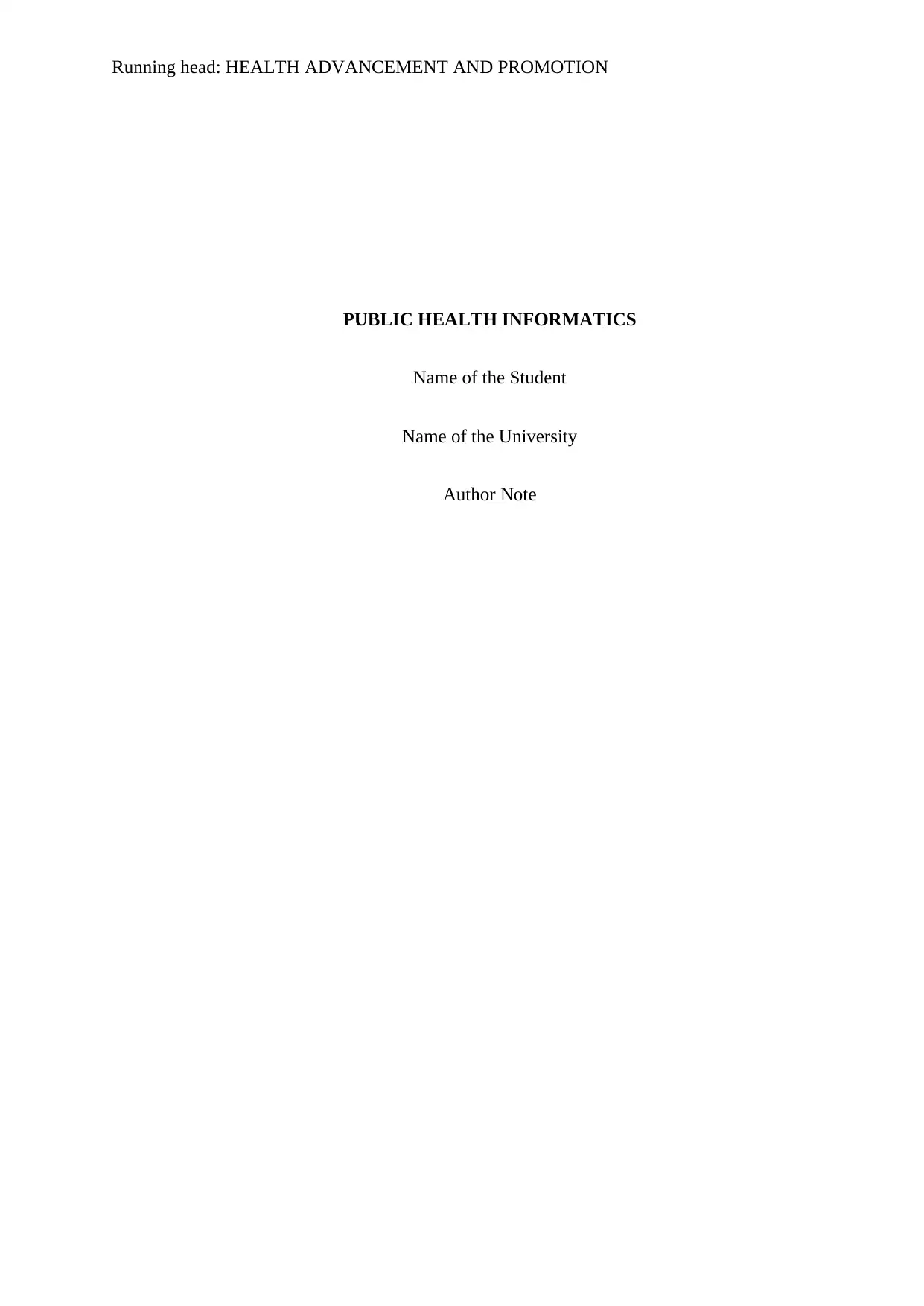
Running head: HEALTH ADVANCEMENT AND PROMOTION
PUBLIC HEALTH INFORMATICS
Name of the Student
Name of the University
Author Note
PUBLIC HEALTH INFORMATICS
Name of the Student
Name of the University
Author Note
Paraphrase This Document
Need a fresh take? Get an instant paraphrase of this document with our AI Paraphraser

1HEALTH ADVANCEMENT AND PROMOTION
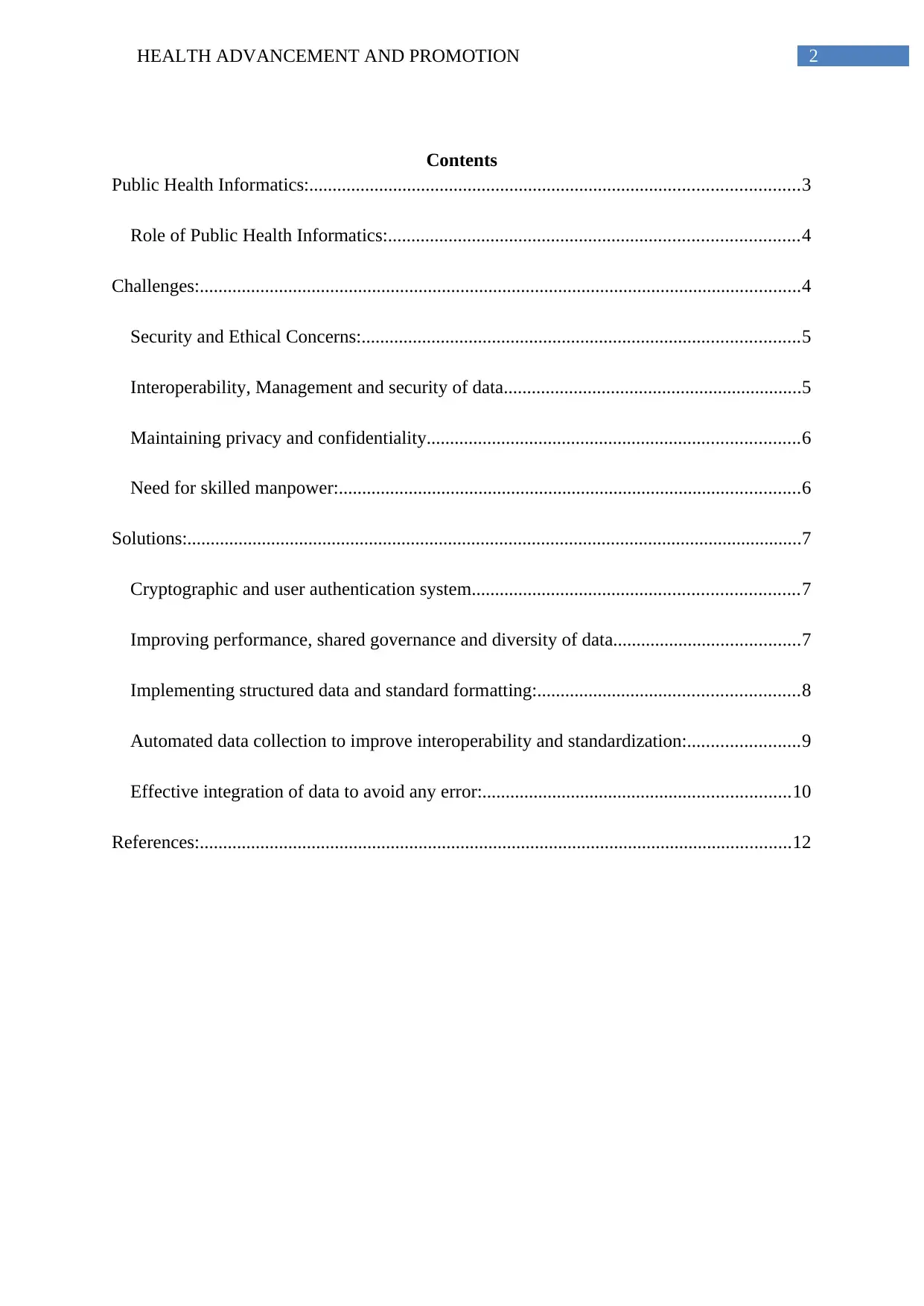
2HEALTH ADVANCEMENT AND PROMOTION
Contents
Public Health Informatics:.........................................................................................................3
Role of Public Health Informatics:........................................................................................4
Challenges:.................................................................................................................................4
Security and Ethical Concerns:..............................................................................................5
Interoperability, Management and security of data................................................................5
Maintaining privacy and confidentiality................................................................................6
Need for skilled manpower:...................................................................................................6
Solutions:....................................................................................................................................7
Cryptographic and user authentication system......................................................................7
Improving performance, shared governance and diversity of data........................................7
Implementing structured data and standard formatting:........................................................8
Automated data collection to improve interoperability and standardization:........................9
Effective integration of data to avoid any error:..................................................................10
References:...............................................................................................................................12
Contents
Public Health Informatics:.........................................................................................................3
Role of Public Health Informatics:........................................................................................4
Challenges:.................................................................................................................................4
Security and Ethical Concerns:..............................................................................................5
Interoperability, Management and security of data................................................................5
Maintaining privacy and confidentiality................................................................................6
Need for skilled manpower:...................................................................................................6
Solutions:....................................................................................................................................7
Cryptographic and user authentication system......................................................................7
Improving performance, shared governance and diversity of data........................................7
Implementing structured data and standard formatting:........................................................8
Automated data collection to improve interoperability and standardization:........................9
Effective integration of data to avoid any error:..................................................................10
References:...............................................................................................................................12
⊘ This is a preview!⊘
Do you want full access?
Subscribe today to unlock all pages.

Trusted by 1+ million students worldwide
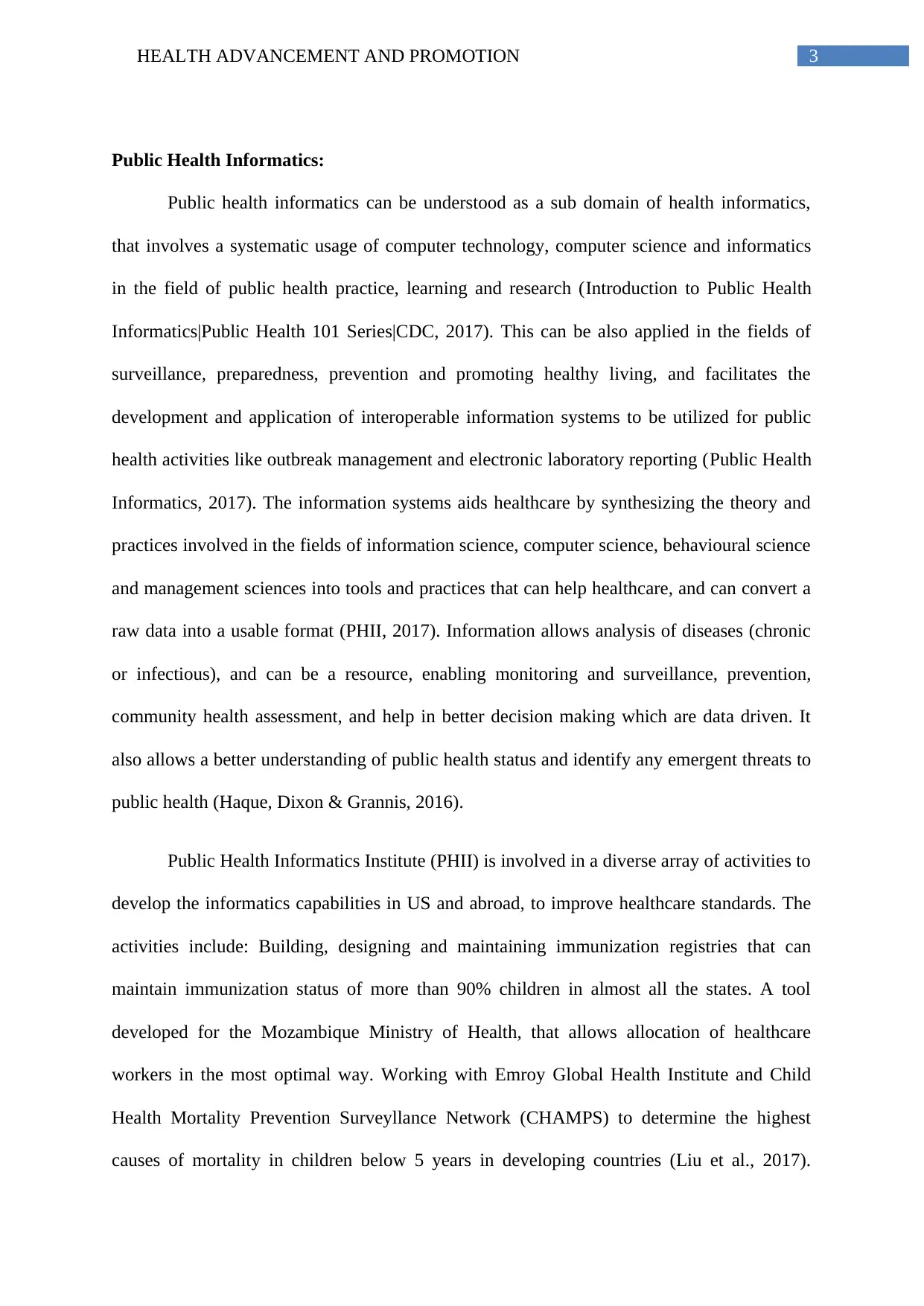
3HEALTH ADVANCEMENT AND PROMOTION
Public Health Informatics:
Public health informatics can be understood as a sub domain of health informatics,
that involves a systematic usage of computer technology, computer science and informatics
in the field of public health practice, learning and research (Introduction to Public Health
Informatics|Public Health 101 Series|CDC, 2017). This can be also applied in the fields of
surveillance, preparedness, prevention and promoting healthy living, and facilitates the
development and application of interoperable information systems to be utilized for public
health activities like outbreak management and electronic laboratory reporting (Public Health
Informatics, 2017). The information systems aids healthcare by synthesizing the theory and
practices involved in the fields of information science, computer science, behavioural science
and management sciences into tools and practices that can help healthcare, and can convert a
raw data into a usable format (PHII, 2017). Information allows analysis of diseases (chronic
or infectious), and can be a resource, enabling monitoring and surveillance, prevention,
community health assessment, and help in better decision making which are data driven. It
also allows a better understanding of public health status and identify any emergent threats to
public health (Haque, Dixon & Grannis, 2016).
Public Health Informatics Institute (PHII) is involved in a diverse array of activities to
develop the informatics capabilities in US and abroad, to improve healthcare standards. The
activities include: Building, designing and maintaining immunization registries that can
maintain immunization status of more than 90% children in almost all the states. A tool
developed for the Mozambique Ministry of Health, that allows allocation of healthcare
workers in the most optimal way. Working with Emroy Global Health Institute and Child
Health Mortality Prevention Surveyllance Network (CHAMPS) to determine the highest
causes of mortality in children below 5 years in developing countries (Liu et al., 2017).
Public Health Informatics:
Public health informatics can be understood as a sub domain of health informatics,
that involves a systematic usage of computer technology, computer science and informatics
in the field of public health practice, learning and research (Introduction to Public Health
Informatics|Public Health 101 Series|CDC, 2017). This can be also applied in the fields of
surveillance, preparedness, prevention and promoting healthy living, and facilitates the
development and application of interoperable information systems to be utilized for public
health activities like outbreak management and electronic laboratory reporting (Public Health
Informatics, 2017). The information systems aids healthcare by synthesizing the theory and
practices involved in the fields of information science, computer science, behavioural science
and management sciences into tools and practices that can help healthcare, and can convert a
raw data into a usable format (PHII, 2017). Information allows analysis of diseases (chronic
or infectious), and can be a resource, enabling monitoring and surveillance, prevention,
community health assessment, and help in better decision making which are data driven. It
also allows a better understanding of public health status and identify any emergent threats to
public health (Haque, Dixon & Grannis, 2016).
Public Health Informatics Institute (PHII) is involved in a diverse array of activities to
develop the informatics capabilities in US and abroad, to improve healthcare standards. The
activities include: Building, designing and maintaining immunization registries that can
maintain immunization status of more than 90% children in almost all the states. A tool
developed for the Mozambique Ministry of Health, that allows allocation of healthcare
workers in the most optimal way. Working with Emroy Global Health Institute and Child
Health Mortality Prevention Surveyllance Network (CHAMPS) to determine the highest
causes of mortality in children below 5 years in developing countries (Liu et al., 2017).
Paraphrase This Document
Need a fresh take? Get an instant paraphrase of this document with our AI Paraphraser
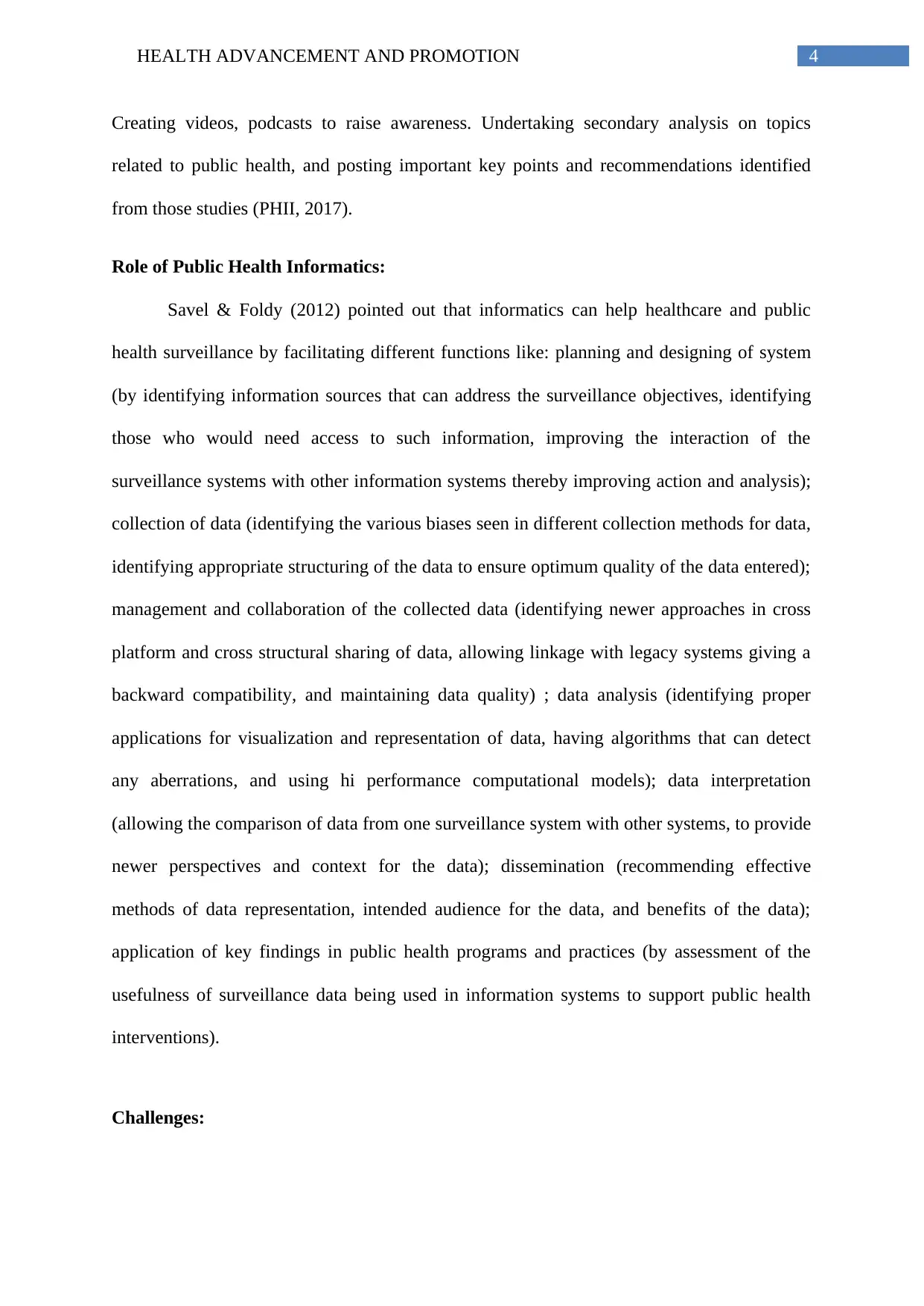
4HEALTH ADVANCEMENT AND PROMOTION
Creating videos, podcasts to raise awareness. Undertaking secondary analysis on topics
related to public health, and posting important key points and recommendations identified
from those studies (PHII, 2017).
Role of Public Health Informatics:
Savel & Foldy (2012) pointed out that informatics can help healthcare and public
health surveillance by facilitating different functions like: planning and designing of system
(by identifying information sources that can address the surveillance objectives, identifying
those who would need access to such information, improving the interaction of the
surveillance systems with other information systems thereby improving action and analysis);
collection of data (identifying the various biases seen in different collection methods for data,
identifying appropriate structuring of the data to ensure optimum quality of the data entered);
management and collaboration of the collected data (identifying newer approaches in cross
platform and cross structural sharing of data, allowing linkage with legacy systems giving a
backward compatibility, and maintaining data quality) ; data analysis (identifying proper
applications for visualization and representation of data, having algorithms that can detect
any aberrations, and using hi performance computational models); data interpretation
(allowing the comparison of data from one surveillance system with other systems, to provide
newer perspectives and context for the data); dissemination (recommending effective
methods of data representation, intended audience for the data, and benefits of the data);
application of key findings in public health programs and practices (by assessment of the
usefulness of surveillance data being used in information systems to support public health
interventions).
Challenges:
Creating videos, podcasts to raise awareness. Undertaking secondary analysis on topics
related to public health, and posting important key points and recommendations identified
from those studies (PHII, 2017).
Role of Public Health Informatics:
Savel & Foldy (2012) pointed out that informatics can help healthcare and public
health surveillance by facilitating different functions like: planning and designing of system
(by identifying information sources that can address the surveillance objectives, identifying
those who would need access to such information, improving the interaction of the
surveillance systems with other information systems thereby improving action and analysis);
collection of data (identifying the various biases seen in different collection methods for data,
identifying appropriate structuring of the data to ensure optimum quality of the data entered);
management and collaboration of the collected data (identifying newer approaches in cross
platform and cross structural sharing of data, allowing linkage with legacy systems giving a
backward compatibility, and maintaining data quality) ; data analysis (identifying proper
applications for visualization and representation of data, having algorithms that can detect
any aberrations, and using hi performance computational models); data interpretation
(allowing the comparison of data from one surveillance system with other systems, to provide
newer perspectives and context for the data); dissemination (recommending effective
methods of data representation, intended audience for the data, and benefits of the data);
application of key findings in public health programs and practices (by assessment of the
usefulness of surveillance data being used in information systems to support public health
interventions).
Challenges:
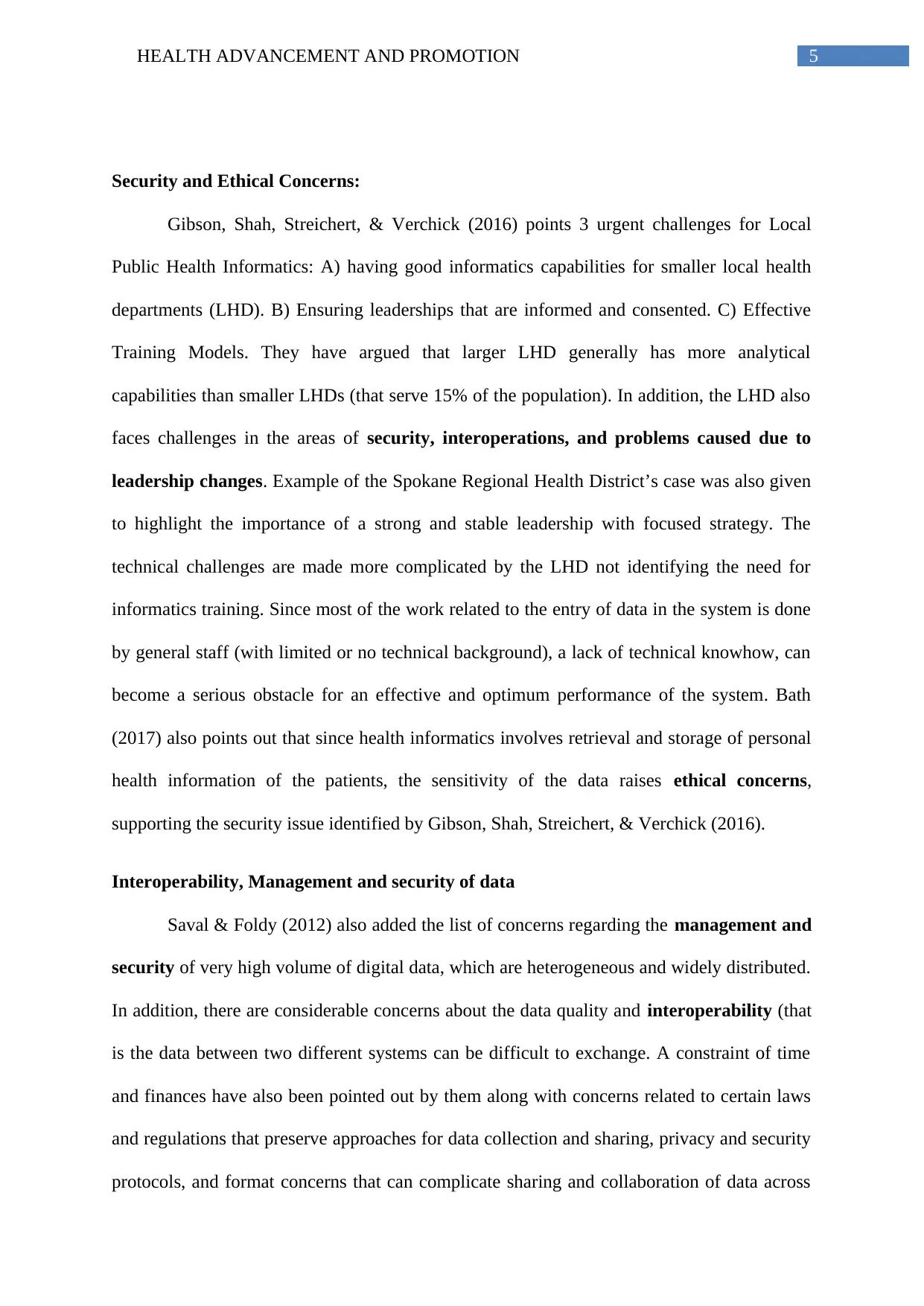
5HEALTH ADVANCEMENT AND PROMOTION
Security and Ethical Concerns:
Gibson, Shah, Streichert, & Verchick (2016) points 3 urgent challenges for Local
Public Health Informatics: A) having good informatics capabilities for smaller local health
departments (LHD). B) Ensuring leaderships that are informed and consented. C) Effective
Training Models. They have argued that larger LHD generally has more analytical
capabilities than smaller LHDs (that serve 15% of the population). In addition, the LHD also
faces challenges in the areas of security, interoperations, and problems caused due to
leadership changes. Example of the Spokane Regional Health District’s case was also given
to highlight the importance of a strong and stable leadership with focused strategy. The
technical challenges are made more complicated by the LHD not identifying the need for
informatics training. Since most of the work related to the entry of data in the system is done
by general staff (with limited or no technical background), a lack of technical knowhow, can
become a serious obstacle for an effective and optimum performance of the system. Bath
(2017) also points out that since health informatics involves retrieval and storage of personal
health information of the patients, the sensitivity of the data raises ethical concerns,
supporting the security issue identified by Gibson, Shah, Streichert, & Verchick (2016).
Interoperability, Management and security of data
Saval & Foldy (2012) also added the list of concerns regarding the management and
security of very high volume of digital data, which are heterogeneous and widely distributed.
In addition, there are considerable concerns about the data quality and interoperability (that
is the data between two different systems can be difficult to exchange. A constraint of time
and finances have also been pointed out by them along with concerns related to certain laws
and regulations that preserve approaches for data collection and sharing, privacy and security
protocols, and format concerns that can complicate sharing and collaboration of data across
Security and Ethical Concerns:
Gibson, Shah, Streichert, & Verchick (2016) points 3 urgent challenges for Local
Public Health Informatics: A) having good informatics capabilities for smaller local health
departments (LHD). B) Ensuring leaderships that are informed and consented. C) Effective
Training Models. They have argued that larger LHD generally has more analytical
capabilities than smaller LHDs (that serve 15% of the population). In addition, the LHD also
faces challenges in the areas of security, interoperations, and problems caused due to
leadership changes. Example of the Spokane Regional Health District’s case was also given
to highlight the importance of a strong and stable leadership with focused strategy. The
technical challenges are made more complicated by the LHD not identifying the need for
informatics training. Since most of the work related to the entry of data in the system is done
by general staff (with limited or no technical background), a lack of technical knowhow, can
become a serious obstacle for an effective and optimum performance of the system. Bath
(2017) also points out that since health informatics involves retrieval and storage of personal
health information of the patients, the sensitivity of the data raises ethical concerns,
supporting the security issue identified by Gibson, Shah, Streichert, & Verchick (2016).
Interoperability, Management and security of data
Saval & Foldy (2012) also added the list of concerns regarding the management and
security of very high volume of digital data, which are heterogeneous and widely distributed.
In addition, there are considerable concerns about the data quality and interoperability (that
is the data between two different systems can be difficult to exchange. A constraint of time
and finances have also been pointed out by them along with concerns related to certain laws
and regulations that preserve approaches for data collection and sharing, privacy and security
protocols, and format concerns that can complicate sharing and collaboration of data across
⊘ This is a preview!⊘
Do you want full access?
Subscribe today to unlock all pages.

Trusted by 1+ million students worldwide
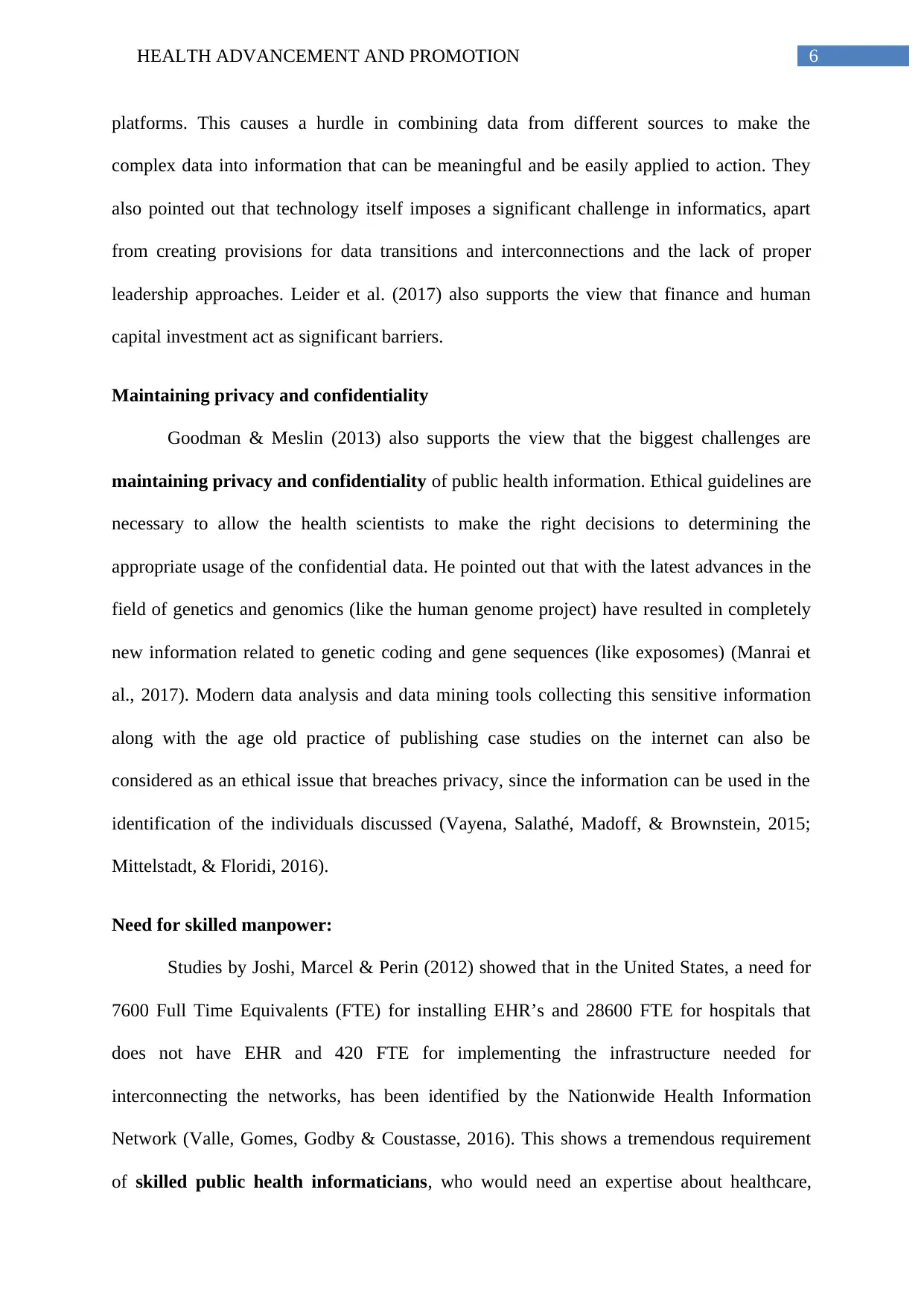
6HEALTH ADVANCEMENT AND PROMOTION
platforms. This causes a hurdle in combining data from different sources to make the
complex data into information that can be meaningful and be easily applied to action. They
also pointed out that technology itself imposes a significant challenge in informatics, apart
from creating provisions for data transitions and interconnections and the lack of proper
leadership approaches. Leider et al. (2017) also supports the view that finance and human
capital investment act as significant barriers.
Maintaining privacy and confidentiality
Goodman & Meslin (2013) also supports the view that the biggest challenges are
maintaining privacy and confidentiality of public health information. Ethical guidelines are
necessary to allow the health scientists to make the right decisions to determining the
appropriate usage of the confidential data. He pointed out that with the latest advances in the
field of genetics and genomics (like the human genome project) have resulted in completely
new information related to genetic coding and gene sequences (like exposomes) (Manrai et
al., 2017). Modern data analysis and data mining tools collecting this sensitive information
along with the age old practice of publishing case studies on the internet can also be
considered as an ethical issue that breaches privacy, since the information can be used in the
identification of the individuals discussed (Vayena, Salathé, Madoff, & Brownstein, 2015;
Mittelstadt, & Floridi, 2016).
Need for skilled manpower:
Studies by Joshi, Marcel & Perin (2012) showed that in the United States, a need for
7600 Full Time Equivalents (FTE) for installing EHR’s and 28600 FTE for hospitals that
does not have EHR and 420 FTE for implementing the infrastructure needed for
interconnecting the networks, has been identified by the Nationwide Health Information
Network (Valle, Gomes, Godby & Coustasse, 2016). This shows a tremendous requirement
of skilled public health informaticians, who would need an expertise about healthcare,
platforms. This causes a hurdle in combining data from different sources to make the
complex data into information that can be meaningful and be easily applied to action. They
also pointed out that technology itself imposes a significant challenge in informatics, apart
from creating provisions for data transitions and interconnections and the lack of proper
leadership approaches. Leider et al. (2017) also supports the view that finance and human
capital investment act as significant barriers.
Maintaining privacy and confidentiality
Goodman & Meslin (2013) also supports the view that the biggest challenges are
maintaining privacy and confidentiality of public health information. Ethical guidelines are
necessary to allow the health scientists to make the right decisions to determining the
appropriate usage of the confidential data. He pointed out that with the latest advances in the
field of genetics and genomics (like the human genome project) have resulted in completely
new information related to genetic coding and gene sequences (like exposomes) (Manrai et
al., 2017). Modern data analysis and data mining tools collecting this sensitive information
along with the age old practice of publishing case studies on the internet can also be
considered as an ethical issue that breaches privacy, since the information can be used in the
identification of the individuals discussed (Vayena, Salathé, Madoff, & Brownstein, 2015;
Mittelstadt, & Floridi, 2016).
Need for skilled manpower:
Studies by Joshi, Marcel & Perin (2012) showed that in the United States, a need for
7600 Full Time Equivalents (FTE) for installing EHR’s and 28600 FTE for hospitals that
does not have EHR and 420 FTE for implementing the infrastructure needed for
interconnecting the networks, has been identified by the Nationwide Health Information
Network (Valle, Gomes, Godby & Coustasse, 2016). This shows a tremendous requirement
of skilled public health informaticians, who would need an expertise about healthcare,
Paraphrase This Document
Need a fresh take? Get an instant paraphrase of this document with our AI Paraphraser
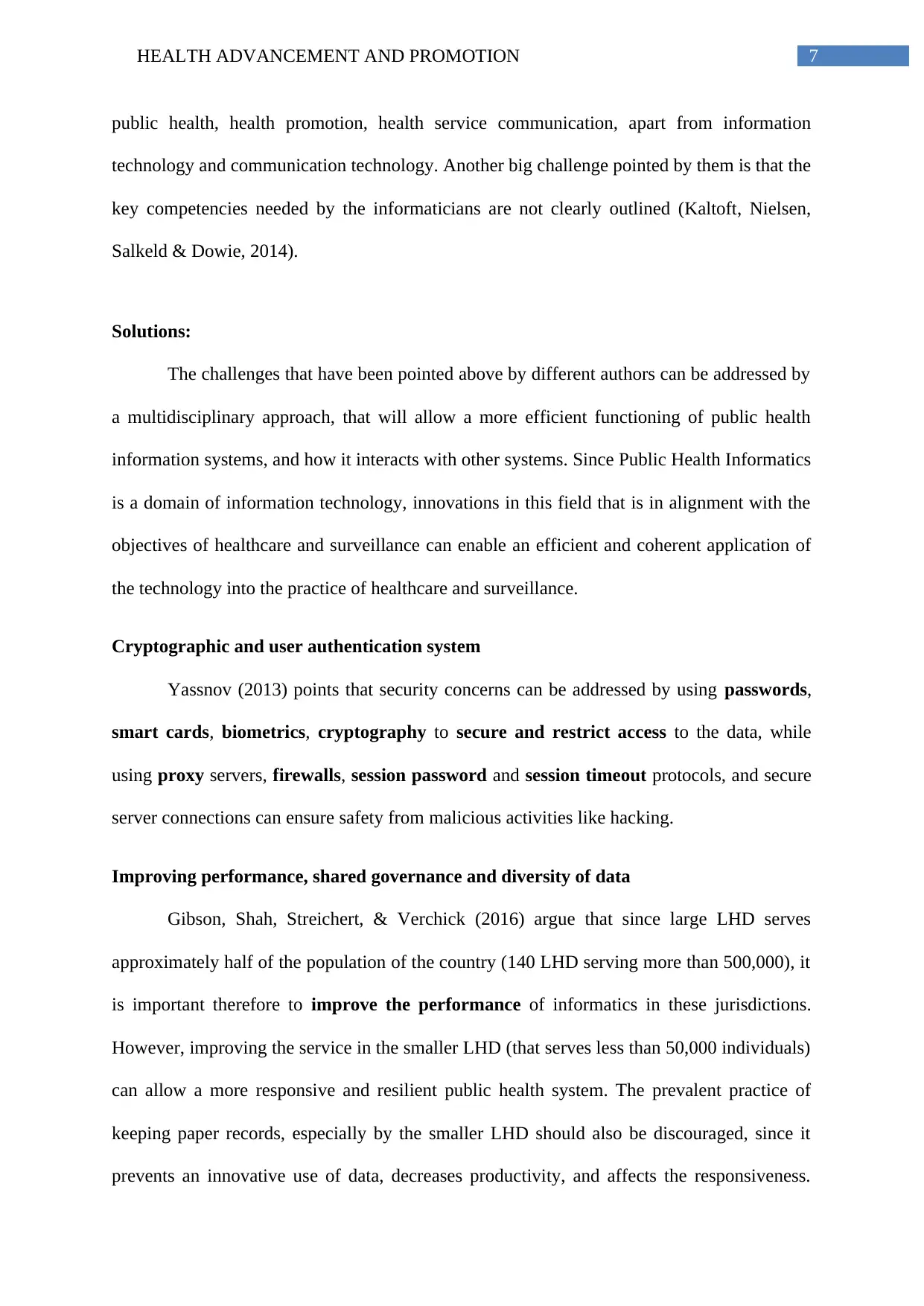
7HEALTH ADVANCEMENT AND PROMOTION
public health, health promotion, health service communication, apart from information
technology and communication technology. Another big challenge pointed by them is that the
key competencies needed by the informaticians are not clearly outlined (Kaltoft, Nielsen,
Salkeld & Dowie, 2014).
Solutions:
The challenges that have been pointed above by different authors can be addressed by
a multidisciplinary approach, that will allow a more efficient functioning of public health
information systems, and how it interacts with other systems. Since Public Health Informatics
is a domain of information technology, innovations in this field that is in alignment with the
objectives of healthcare and surveillance can enable an efficient and coherent application of
the technology into the practice of healthcare and surveillance.
Cryptographic and user authentication system
Yassnov (2013) points that security concerns can be addressed by using passwords,
smart cards, biometrics, cryptography to secure and restrict access to the data, while
using proxy servers, firewalls, session password and session timeout protocols, and secure
server connections can ensure safety from malicious activities like hacking.
Improving performance, shared governance and diversity of data
Gibson, Shah, Streichert, & Verchick (2016) argue that since large LHD serves
approximately half of the population of the country (140 LHD serving more than 500,000), it
is important therefore to improve the performance of informatics in these jurisdictions.
However, improving the service in the smaller LHD (that serves less than 50,000 individuals)
can allow a more responsive and resilient public health system. The prevalent practice of
keeping paper records, especially by the smaller LHD should also be discouraged, since it
prevents an innovative use of data, decreases productivity, and affects the responsiveness.
public health, health promotion, health service communication, apart from information
technology and communication technology. Another big challenge pointed by them is that the
key competencies needed by the informaticians are not clearly outlined (Kaltoft, Nielsen,
Salkeld & Dowie, 2014).
Solutions:
The challenges that have been pointed above by different authors can be addressed by
a multidisciplinary approach, that will allow a more efficient functioning of public health
information systems, and how it interacts with other systems. Since Public Health Informatics
is a domain of information technology, innovations in this field that is in alignment with the
objectives of healthcare and surveillance can enable an efficient and coherent application of
the technology into the practice of healthcare and surveillance.
Cryptographic and user authentication system
Yassnov (2013) points that security concerns can be addressed by using passwords,
smart cards, biometrics, cryptography to secure and restrict access to the data, while
using proxy servers, firewalls, session password and session timeout protocols, and secure
server connections can ensure safety from malicious activities like hacking.
Improving performance, shared governance and diversity of data
Gibson, Shah, Streichert, & Verchick (2016) argue that since large LHD serves
approximately half of the population of the country (140 LHD serving more than 500,000), it
is important therefore to improve the performance of informatics in these jurisdictions.
However, improving the service in the smaller LHD (that serves less than 50,000 individuals)
can allow a more responsive and resilient public health system. The prevalent practice of
keeping paper records, especially by the smaller LHD should also be discouraged, since it
prevents an innovative use of data, decreases productivity, and affects the responsiveness.
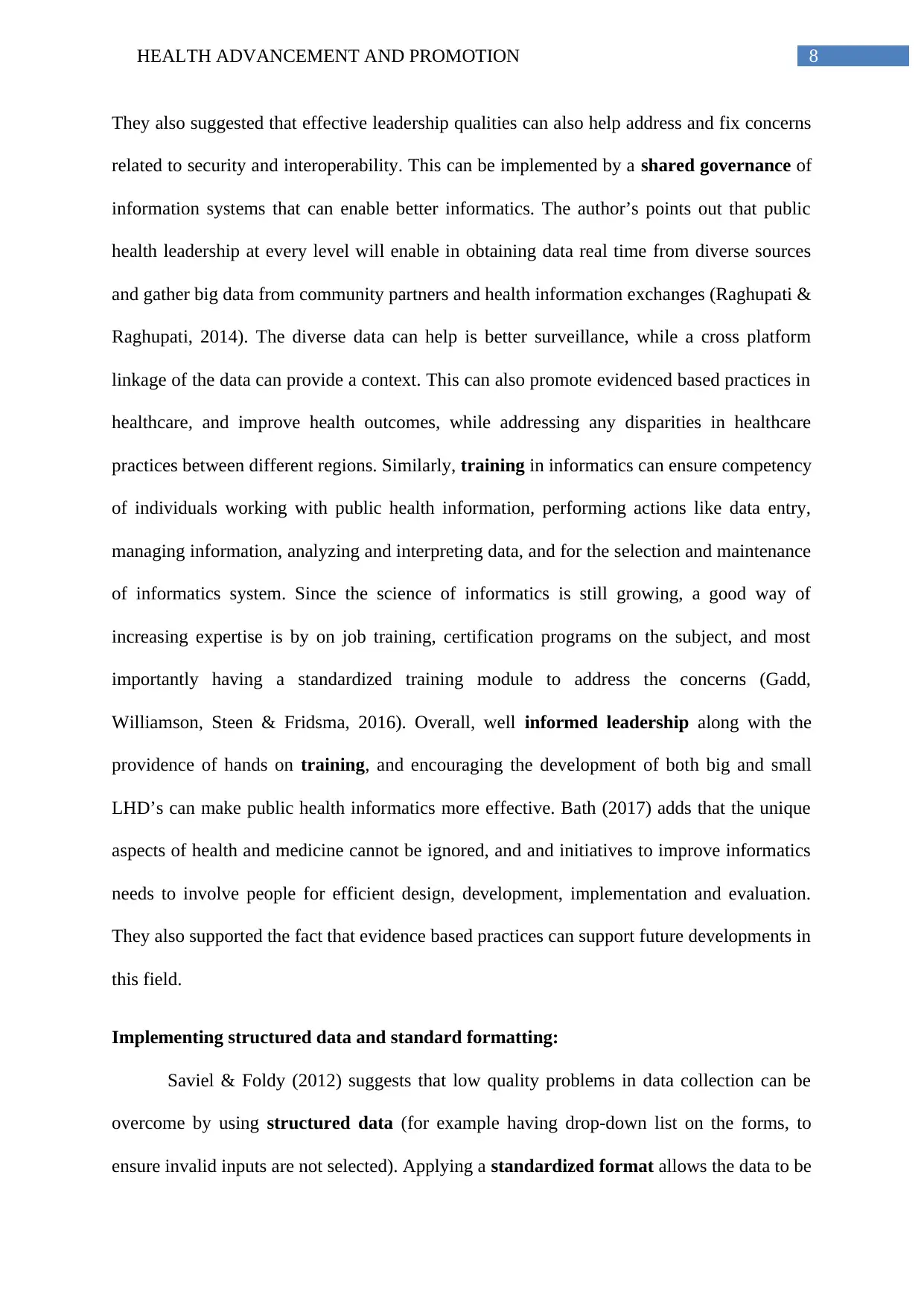
8HEALTH ADVANCEMENT AND PROMOTION
They also suggested that effective leadership qualities can also help address and fix concerns
related to security and interoperability. This can be implemented by a shared governance of
information systems that can enable better informatics. The author’s points out that public
health leadership at every level will enable in obtaining data real time from diverse sources
and gather big data from community partners and health information exchanges (Raghupati &
Raghupati, 2014). The diverse data can help is better surveillance, while a cross platform
linkage of the data can provide a context. This can also promote evidenced based practices in
healthcare, and improve health outcomes, while addressing any disparities in healthcare
practices between different regions. Similarly, training in informatics can ensure competency
of individuals working with public health information, performing actions like data entry,
managing information, analyzing and interpreting data, and for the selection and maintenance
of informatics system. Since the science of informatics is still growing, a good way of
increasing expertise is by on job training, certification programs on the subject, and most
importantly having a standardized training module to address the concerns (Gadd,
Williamson, Steen & Fridsma, 2016). Overall, well informed leadership along with the
providence of hands on training, and encouraging the development of both big and small
LHD’s can make public health informatics more effective. Bath (2017) adds that the unique
aspects of health and medicine cannot be ignored, and and initiatives to improve informatics
needs to involve people for efficient design, development, implementation and evaluation.
They also supported the fact that evidence based practices can support future developments in
this field.
Implementing structured data and standard formatting:
Saviel & Foldy (2012) suggests that low quality problems in data collection can be
overcome by using structured data (for example having drop-down list on the forms, to
ensure invalid inputs are not selected). Applying a standardized format allows the data to be
They also suggested that effective leadership qualities can also help address and fix concerns
related to security and interoperability. This can be implemented by a shared governance of
information systems that can enable better informatics. The author’s points out that public
health leadership at every level will enable in obtaining data real time from diverse sources
and gather big data from community partners and health information exchanges (Raghupati &
Raghupati, 2014). The diverse data can help is better surveillance, while a cross platform
linkage of the data can provide a context. This can also promote evidenced based practices in
healthcare, and improve health outcomes, while addressing any disparities in healthcare
practices between different regions. Similarly, training in informatics can ensure competency
of individuals working with public health information, performing actions like data entry,
managing information, analyzing and interpreting data, and for the selection and maintenance
of informatics system. Since the science of informatics is still growing, a good way of
increasing expertise is by on job training, certification programs on the subject, and most
importantly having a standardized training module to address the concerns (Gadd,
Williamson, Steen & Fridsma, 2016). Overall, well informed leadership along with the
providence of hands on training, and encouraging the development of both big and small
LHD’s can make public health informatics more effective. Bath (2017) adds that the unique
aspects of health and medicine cannot be ignored, and and initiatives to improve informatics
needs to involve people for efficient design, development, implementation and evaluation.
They also supported the fact that evidence based practices can support future developments in
this field.
Implementing structured data and standard formatting:
Saviel & Foldy (2012) suggests that low quality problems in data collection can be
overcome by using structured data (for example having drop-down list on the forms, to
ensure invalid inputs are not selected). Applying a standardized format allows the data to be
⊘ This is a preview!⊘
Do you want full access?
Subscribe today to unlock all pages.

Trusted by 1+ million students worldwide
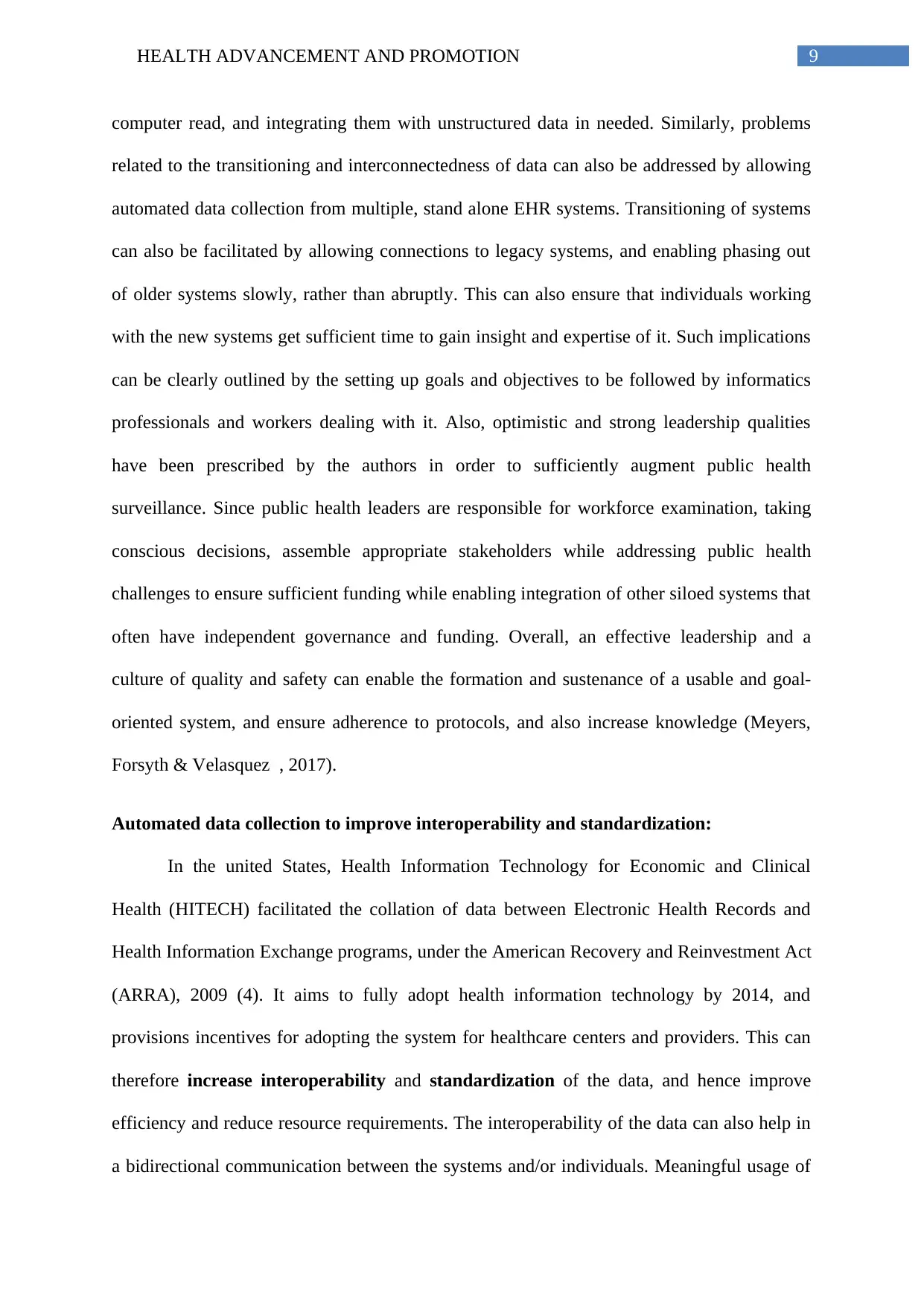
9HEALTH ADVANCEMENT AND PROMOTION
computer read, and integrating them with unstructured data in needed. Similarly, problems
related to the transitioning and interconnectedness of data can also be addressed by allowing
automated data collection from multiple, stand alone EHR systems. Transitioning of systems
can also be facilitated by allowing connections to legacy systems, and enabling phasing out
of older systems slowly, rather than abruptly. This can also ensure that individuals working
with the new systems get sufficient time to gain insight and expertise of it. Such implications
can be clearly outlined by the setting up goals and objectives to be followed by informatics
professionals and workers dealing with it. Also, optimistic and strong leadership qualities
have been prescribed by the authors in order to sufficiently augment public health
surveillance. Since public health leaders are responsible for workforce examination, taking
conscious decisions, assemble appropriate stakeholders while addressing public health
challenges to ensure sufficient funding while enabling integration of other siloed systems that
often have independent governance and funding. Overall, an effective leadership and a
culture of quality and safety can enable the formation and sustenance of a usable and goal-
oriented system, and ensure adherence to protocols, and also increase knowledge (Meyers,
Forsyth & Velasquez , 2017).
Automated data collection to improve interoperability and standardization:
In the united States, Health Information Technology for Economic and Clinical
Health (HITECH) facilitated the collation of data between Electronic Health Records and
Health Information Exchange programs, under the American Recovery and Reinvestment Act
(ARRA), 2009 (4). It aims to fully adopt health information technology by 2014, and
provisions incentives for adopting the system for healthcare centers and providers. This can
therefore increase interoperability and standardization of the data, and hence improve
efficiency and reduce resource requirements. The interoperability of the data can also help in
a bidirectional communication between the systems and/or individuals. Meaningful usage of
computer read, and integrating them with unstructured data in needed. Similarly, problems
related to the transitioning and interconnectedness of data can also be addressed by allowing
automated data collection from multiple, stand alone EHR systems. Transitioning of systems
can also be facilitated by allowing connections to legacy systems, and enabling phasing out
of older systems slowly, rather than abruptly. This can also ensure that individuals working
with the new systems get sufficient time to gain insight and expertise of it. Such implications
can be clearly outlined by the setting up goals and objectives to be followed by informatics
professionals and workers dealing with it. Also, optimistic and strong leadership qualities
have been prescribed by the authors in order to sufficiently augment public health
surveillance. Since public health leaders are responsible for workforce examination, taking
conscious decisions, assemble appropriate stakeholders while addressing public health
challenges to ensure sufficient funding while enabling integration of other siloed systems that
often have independent governance and funding. Overall, an effective leadership and a
culture of quality and safety can enable the formation and sustenance of a usable and goal-
oriented system, and ensure adherence to protocols, and also increase knowledge (Meyers,
Forsyth & Velasquez , 2017).
Automated data collection to improve interoperability and standardization:
In the united States, Health Information Technology for Economic and Clinical
Health (HITECH) facilitated the collation of data between Electronic Health Records and
Health Information Exchange programs, under the American Recovery and Reinvestment Act
(ARRA), 2009 (4). It aims to fully adopt health information technology by 2014, and
provisions incentives for adopting the system for healthcare centers and providers. This can
therefore increase interoperability and standardization of the data, and hence improve
efficiency and reduce resource requirements. The interoperability of the data can also help in
a bidirectional communication between the systems and/or individuals. Meaningful usage of
Paraphrase This Document
Need a fresh take? Get an instant paraphrase of this document with our AI Paraphraser
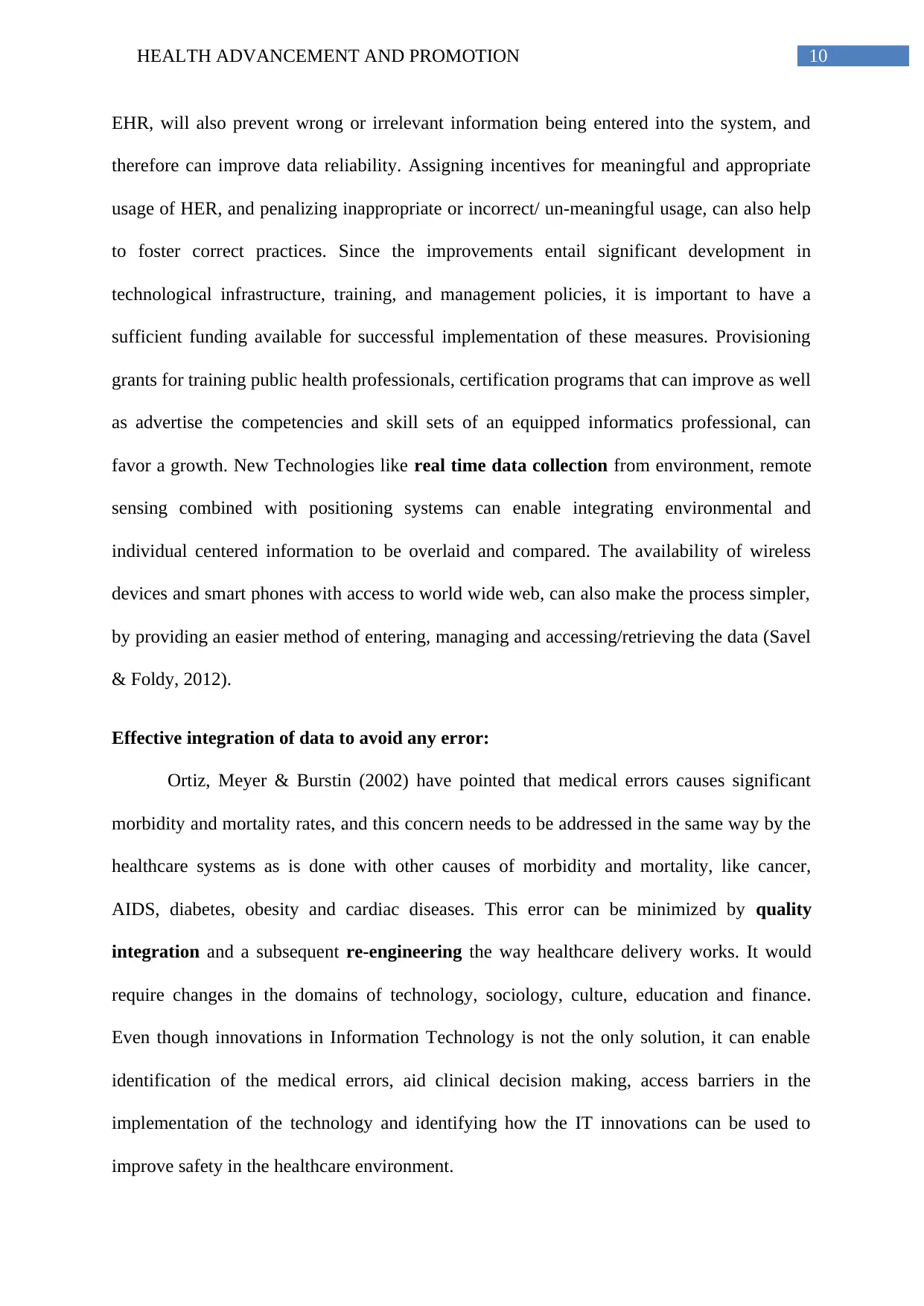
10HEALTH ADVANCEMENT AND PROMOTION
EHR, will also prevent wrong or irrelevant information being entered into the system, and
therefore can improve data reliability. Assigning incentives for meaningful and appropriate
usage of HER, and penalizing inappropriate or incorrect/ un-meaningful usage, can also help
to foster correct practices. Since the improvements entail significant development in
technological infrastructure, training, and management policies, it is important to have a
sufficient funding available for successful implementation of these measures. Provisioning
grants for training public health professionals, certification programs that can improve as well
as advertise the competencies and skill sets of an equipped informatics professional, can
favor a growth. New Technologies like real time data collection from environment, remote
sensing combined with positioning systems can enable integrating environmental and
individual centered information to be overlaid and compared. The availability of wireless
devices and smart phones with access to world wide web, can also make the process simpler,
by providing an easier method of entering, managing and accessing/retrieving the data (Savel
& Foldy, 2012).
Effective integration of data to avoid any error:
Ortiz, Meyer & Burstin (2002) have pointed that medical errors causes significant
morbidity and mortality rates, and this concern needs to be addressed in the same way by the
healthcare systems as is done with other causes of morbidity and mortality, like cancer,
AIDS, diabetes, obesity and cardiac diseases. This error can be minimized by quality
integration and a subsequent re-engineering the way healthcare delivery works. It would
require changes in the domains of technology, sociology, culture, education and finance.
Even though innovations in Information Technology is not the only solution, it can enable
identification of the medical errors, aid clinical decision making, access barriers in the
implementation of the technology and identifying how the IT innovations can be used to
improve safety in the healthcare environment.
EHR, will also prevent wrong or irrelevant information being entered into the system, and
therefore can improve data reliability. Assigning incentives for meaningful and appropriate
usage of HER, and penalizing inappropriate or incorrect/ un-meaningful usage, can also help
to foster correct practices. Since the improvements entail significant development in
technological infrastructure, training, and management policies, it is important to have a
sufficient funding available for successful implementation of these measures. Provisioning
grants for training public health professionals, certification programs that can improve as well
as advertise the competencies and skill sets of an equipped informatics professional, can
favor a growth. New Technologies like real time data collection from environment, remote
sensing combined with positioning systems can enable integrating environmental and
individual centered information to be overlaid and compared. The availability of wireless
devices and smart phones with access to world wide web, can also make the process simpler,
by providing an easier method of entering, managing and accessing/retrieving the data (Savel
& Foldy, 2012).
Effective integration of data to avoid any error:
Ortiz, Meyer & Burstin (2002) have pointed that medical errors causes significant
morbidity and mortality rates, and this concern needs to be addressed in the same way by the
healthcare systems as is done with other causes of morbidity and mortality, like cancer,
AIDS, diabetes, obesity and cardiac diseases. This error can be minimized by quality
integration and a subsequent re-engineering the way healthcare delivery works. It would
require changes in the domains of technology, sociology, culture, education and finance.
Even though innovations in Information Technology is not the only solution, it can enable
identification of the medical errors, aid clinical decision making, access barriers in the
implementation of the technology and identifying how the IT innovations can be used to
improve safety in the healthcare environment.
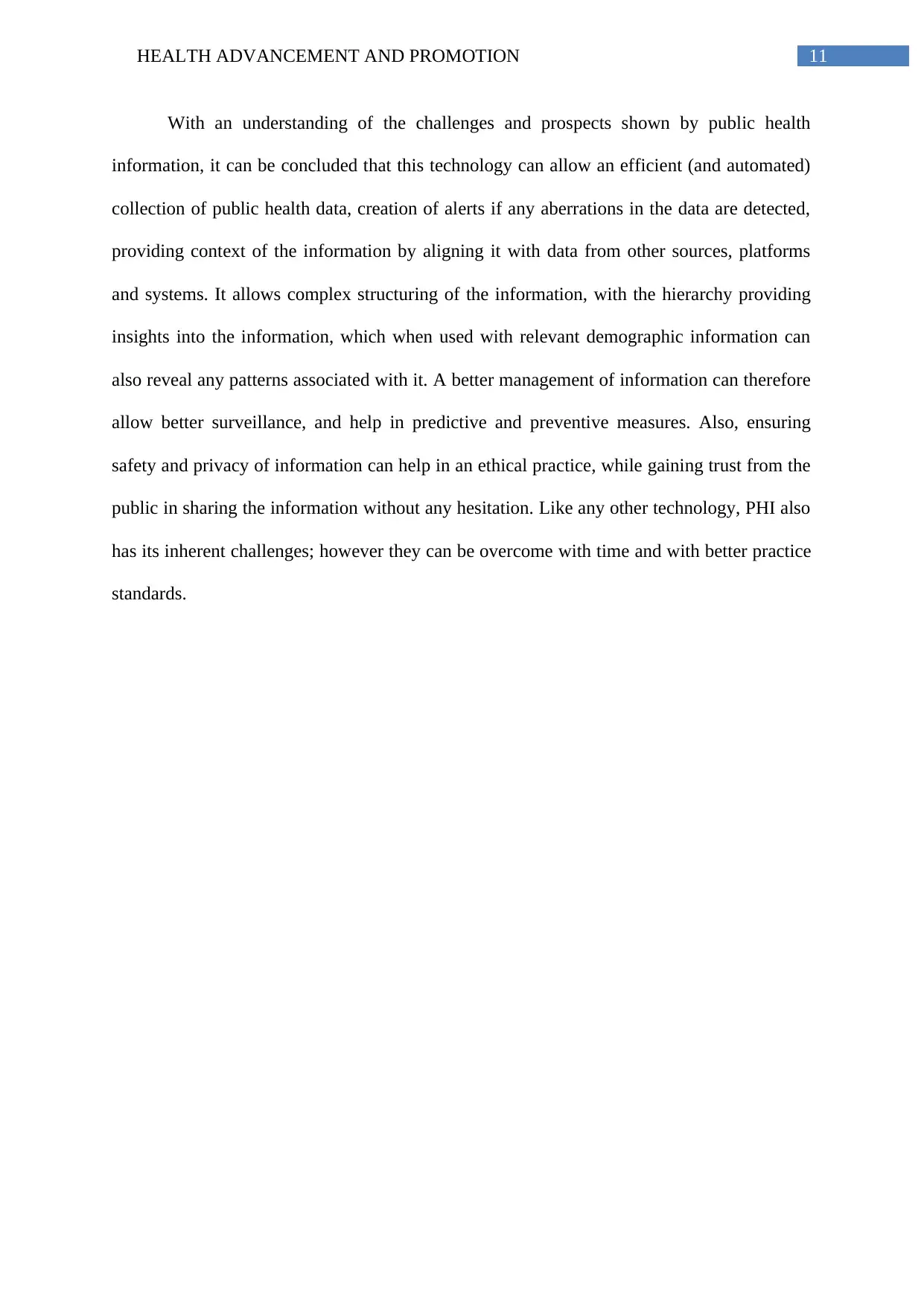
11HEALTH ADVANCEMENT AND PROMOTION
With an understanding of the challenges and prospects shown by public health
information, it can be concluded that this technology can allow an efficient (and automated)
collection of public health data, creation of alerts if any aberrations in the data are detected,
providing context of the information by aligning it with data from other sources, platforms
and systems. It allows complex structuring of the information, with the hierarchy providing
insights into the information, which when used with relevant demographic information can
also reveal any patterns associated with it. A better management of information can therefore
allow better surveillance, and help in predictive and preventive measures. Also, ensuring
safety and privacy of information can help in an ethical practice, while gaining trust from the
public in sharing the information without any hesitation. Like any other technology, PHI also
has its inherent challenges; however they can be overcome with time and with better practice
standards.
With an understanding of the challenges and prospects shown by public health
information, it can be concluded that this technology can allow an efficient (and automated)
collection of public health data, creation of alerts if any aberrations in the data are detected,
providing context of the information by aligning it with data from other sources, platforms
and systems. It allows complex structuring of the information, with the hierarchy providing
insights into the information, which when used with relevant demographic information can
also reveal any patterns associated with it. A better management of information can therefore
allow better surveillance, and help in predictive and preventive measures. Also, ensuring
safety and privacy of information can help in an ethical practice, while gaining trust from the
public in sharing the information without any hesitation. Like any other technology, PHI also
has its inherent challenges; however they can be overcome with time and with better practice
standards.
⊘ This is a preview!⊘
Do you want full access?
Subscribe today to unlock all pages.

Trusted by 1+ million students worldwide
1 out of 14
Related Documents
Your All-in-One AI-Powered Toolkit for Academic Success.
+13062052269
info@desklib.com
Available 24*7 on WhatsApp / Email
![[object Object]](/_next/static/media/star-bottom.7253800d.svg)
Unlock your academic potential
Copyright © 2020–2025 A2Z Services. All Rights Reserved. Developed and managed by ZUCOL.





